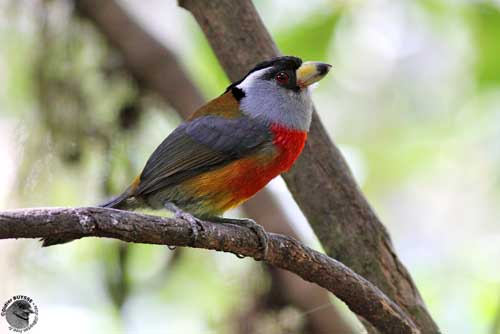
Fr: Cabezon toucan
All : Tukanbartvogel
Esp : Cabezón Tucán
Esp (Colombia): Compás
Esp (Ecuador): Yumbo
Ital : Barbuto tucanetto
Nd: Toekanbaardvogel
Sd: Tukanbarbett
Photographer:
Didier Buysse
Vision d’Oiseaux
Text by Nicole Bouglouan
Sources:
HANDBOOK OF THE BIRDS OF THE WORLD Vol. 7 by Josep del Hoyo-Andrew Elliott-Jordi Sargatal – Lynx Edicions – ISBN: 8487334377
A GUIDE TO THE BIRDS OF COLOMBIA by Steven L. Hilty and William L. Brown - Princeton University Press – ISBN 069108372X
L’ENCYCLOPEDIE MONDIALE DES OISEAUX - Dr Christopher M. Perrins - BORDAS - ISBN: 2040185607
BirdLife International (BirdLife International)
Wikipedia, the free encyclopaedia
Toucan Barbet
Semnornis ramphastinus
Piciformes Order –Semnornithidae Family
BIOMETRICS:
Length: 19-21 cm
Weight: 84-110 gr
DESCRIPTION:
The Toucan Barbet is a brightly coloured arboreal species of the wet forest of Colombia and Ecuador.
On the upperparts, the adult male has golden-olive to brown back, golden rump, grey-blue upperwing and uppertail.
The underparts are red and gold, whereas lower belly and undertail-coverts are pale yellowish-green.
On the head, the area around the bill base is black, extending to lores and crown. There is an erectile black tuft on the nape, and a narrow black nuchal collar. We can see a broad white band behind the eye. Ear-coverts, neck side, chin and throat are pale grey-blue.
The thick bill is short and deep-based, yellowish-white with black subterminal band and whitish tip. The eyes are deep red. Legs and feet are grey.

The female is very similar to the male, but she lacks the erectile black nuchal tuft. The black crown is slightly streaked white. The black subterminal band of the bill is paler than in male.
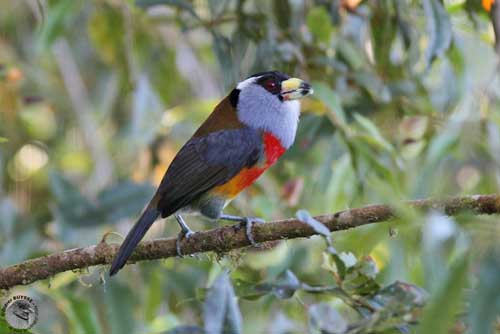
The immature is duller. The bill needs about four months to be fully developed.
There are two subspecies:
S.r. caucae is found in W Colombia on both slopes of W Andes. This race has less extensive red on lower underparts.
S.r. ramphastinus (here described and displayed) is found in Andes of NW and WC Ecuador.
VOICE: SOUNDS BY XENO-CANTO
The Toucan Barbet gives loud series of resonant honking “hawnk” or “aw” notes. These series are sometimes repeated during several minutes, and they even make duets. The male has lower-pitched voice.
They also produce snapping-clicking bill sounds, and clicking sounds including bill snaps, giving something like “bbrripp”, one or two per second. We can also hear “gkaa”, “caw” rattle and chatter notes, purring and contact calls “kyak”.
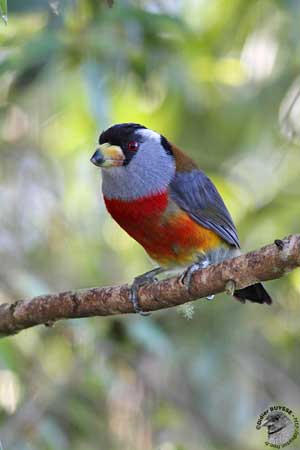
HABITAT:
The Toucan Barbet frequents wet montane forest and edges, and low bushy secondary forest with scattered tall trees. It may feed in isolated pastures with fruiting trees.
This species is usually found between 1000 and 2000 metres of elevation, but it can be seen up to 2400 metres in some areas.
RANGE:
See above in “subspecies”.
BEHAVIOUR:
The Toucan Barbet is usually seen single or in pairs, and they can follow mixed flocks.
They feed on numerous fruits from several plant families. They also take insects such as termites. They forage during several hours every day, hoping actively along branches from mid-level to canopy.
This bird often cocks the tail while climbing upwards, searching for fruits and insects.
Frequent interactions with other Toucan Barbets involve clicking noises.
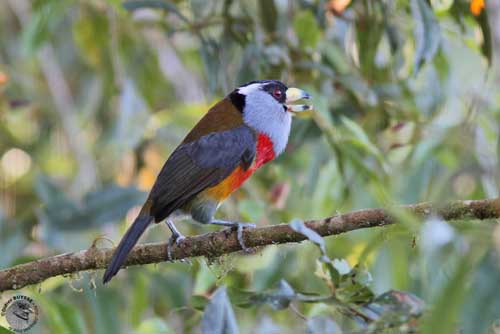
The Toucan Barbet may sit quietly for period, becoming inconspicuous among the foliage. Pairs and small groups move on their own way, independently of mixed flocks of Thraupidae, Tyrannidae and Parulidae species.
The Toucan Barbet is a cavity-nester. The territory is established around a roosting cavity in dead tree. The site is defended against other rivals by the small group consisting of a pair and their young. These helpers also take part in nesting duties.
Singing and duets increase significantly as breeding season starts. The male often cocks the tail near its mate, fluffs the breast feathers, spreads the white supercilium and raises the black nuchal tuft.
Flight displays probably occur, the male using flopping flight when approaching the female. Courtship feeding by male to female may precede copulation.
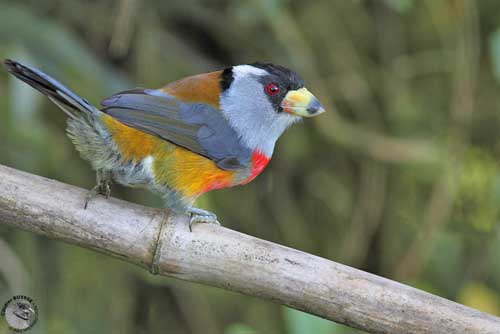
The Toucan Barbet is resident in its range and only performs short dispersions.
FLIGHT:
The Toucan Barbet produces some noise when flying, due to the floppy wing movements.
REPRODUCTION:
The breeding season occurs between February and October.
The Toucan Barbet may produce 2-3 broods per season. They are monogamous. They often form small groups such as trios or quartets, consisting of one pair and one or two young which co-operate for defending the territory and assist the adult pair during the nesting period.
The nest is excavated in dead tree at about 1 to 5 metres above the ground. The cavity-entrance is adapted to the size of the species.
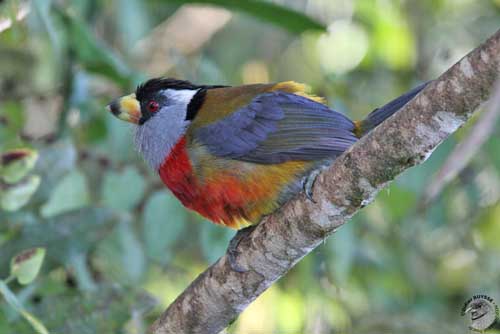
The female lays 2-3 white eggs, and helpers share with her incubation, brooding and feeding of chicks. Incubation lasts two weeks. The young fledge about 43-46 days after hatching. The juveniles may remain with parents as helpers in the following season, while the older young are chased away from the territory. They will depend on parents for 3-4 weeks more.
DIET:
The Toucan Barbet feeds primarily on numerous fruits from several plant species. It also takes some invertebrates such as termites, and small vertebrates such as lizards.
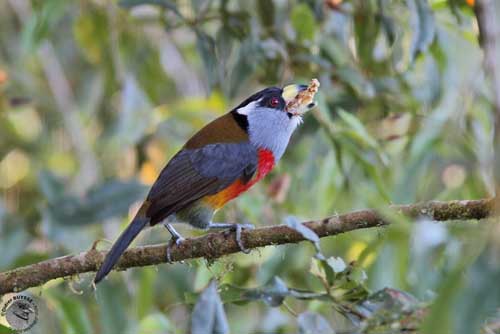
PROTECTION / THREATS / STATUS:
The Toucan Barbet is evaluated as Near Threatened. This species is trapped for cagebird trade and is threatened by habitat loss with destruction of forests. However, the species appears to be adaptable to other habitats if scattered tall trees are present.
The Toucan Barbet occurs in several protected areas, but the uncontrolled human colonisation remains the main threat.
